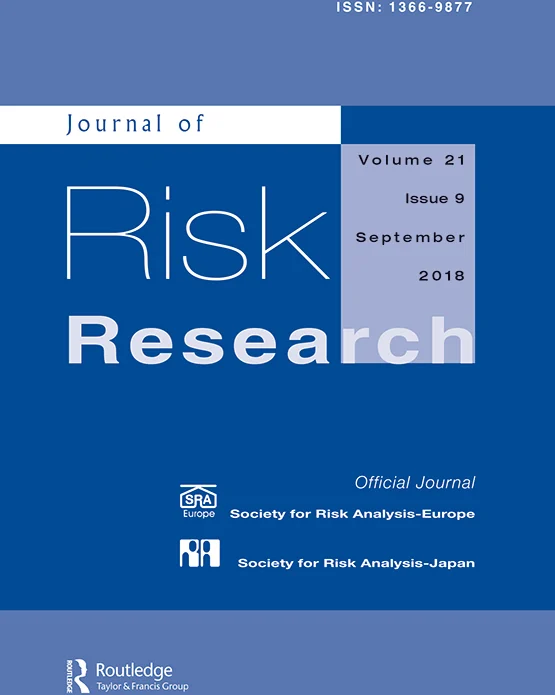风险分析与风险治理——以埃博拉病毒病为例
IF 2.4
4区 管理学
Q1 SOCIAL SCIENCES, INTERDISCIPLINARY
引用次数: 0
摘要
摘要世界风险社会普遍信奉的风险观念和证券化理论影响了两种主要的风险处理方法:风险分析和风险治理。一些学者和政策制定者运用风险概念,认为风险治理优于风险分析。风险分析,被认为是经典的方法,有技术参数,忽略了重要的社会因素。风险治理是一种新兴的方法,它超越了技术,进入了社会参数,因此更具整体性。这种风险分析治理的区别引发了一个问题,即风险治理到底为风险分析增加了什么。为了回答这个问题,文章使用了政策研究中的方法和概念:定性方法,主要是对2013/2014年埃博拉病毒病(EVD)爆发的政策分析,作为案例研究和相关文献的综合,并得到机构和国家来源的二级数据的支持;以及Klinke和Renn(2012)的适应性和综合性风险治理模型,作为指导政策分析的概念框架。据称,根据模型的不同,风险治理主要添加了包含多层次和多利益相关者参与的组件,以增强风险处理。支持这一说法的总体发现是,风险治理在国际风险处理中更加根深蒂固,在很大程度上允许多利益相关者和多层次参与其组成部分,而风险分析通常主导国家风险处理,不允许多利益攸关者在其组成部分下大量参与,尽管它似乎也可以在很大程度上允许多层次的参与。尽管在风险分析中增加了风险治理,但在实践中,这两种方法都未能尽可能具有包容性,这表明风险处理仍有改进的空间。本文章由计算机程序翻译,如有差异,请以英文原文为准。
Risk analysis versus risk governance: the case study of the Ebola Virus Disease
Abstract Risk notions mostly espoused by the world risk society and securitization theories have influenced the two major risk handling methods: risk analysis and risk governance. Engaging the risk notions, some scholars and policy makers have identified risk governance as superior to risk analysis. Risk analysis, considered the classical method, has technical parameters, leaving out important societal considerations. Risk governance, an emerging method, reaches beyond technical into societal parameters, so it is more holistic. This risk analysis-governance distinction prompts the question on what exactly risk governance adds to risk analysis. To answer the question, the article uses methodology and concepts in policy studies: qualitative methods, mainly a policy analysis of the 2013/2014 Ebola Virus Disease (EVD) outbreak as a case study and synthesis of relevant bodies of literature, backed by secondary data from institutional and country sources; and the adaptive and integrative risk governance model of Klinke and Renn (2012) as a conceptual framework to guide the policy analysis. The claim is that, depending on the model, risk governance mainly adds components that incorporate multilevel and multistakeholder participation to enhance risk handling. The overall finding in support of this claim is that risk governance, as more entrenched in international risk handling, considerably allows both multistakeholder and multilevel participation under its components, while risk analysis, generally dominating national risk handling, does not allow substantial multistakeholder participation under its components, although it appears that it could considerably allow multilevel participation as well. Despite the additions of risk governance to risk analysis, as practiced, both methods fail to be as inclusive as possible, suggesting there is room for improvement to risk handling.
求助全文
通过发布文献求助,成功后即可免费获取论文全文。
去求助
来源期刊

Journal of Risk Research
SOCIAL SCIENCES, INTERDISCIPLINARY-
CiteScore
12.20
自引率
5.90%
发文量
44
期刊介绍:
The Journal of Risk Research is an international journal that publishes peer-reviewed theoretical and empirical research articles within the risk field from the areas of social, physical and health sciences and engineering, as well as articles related to decision making, regulation and policy issues in all disciplines. Articles will be published in English. The main aims of the Journal of Risk Research are to stimulate intellectual debate, to promote better risk management practices and to contribute to the development of risk management methodologies. Journal of Risk Research is the official journal of the Society for Risk Analysis Europe and the Society for Risk Analysis Japan.
 求助内容:
求助内容: 应助结果提醒方式:
应助结果提醒方式:


